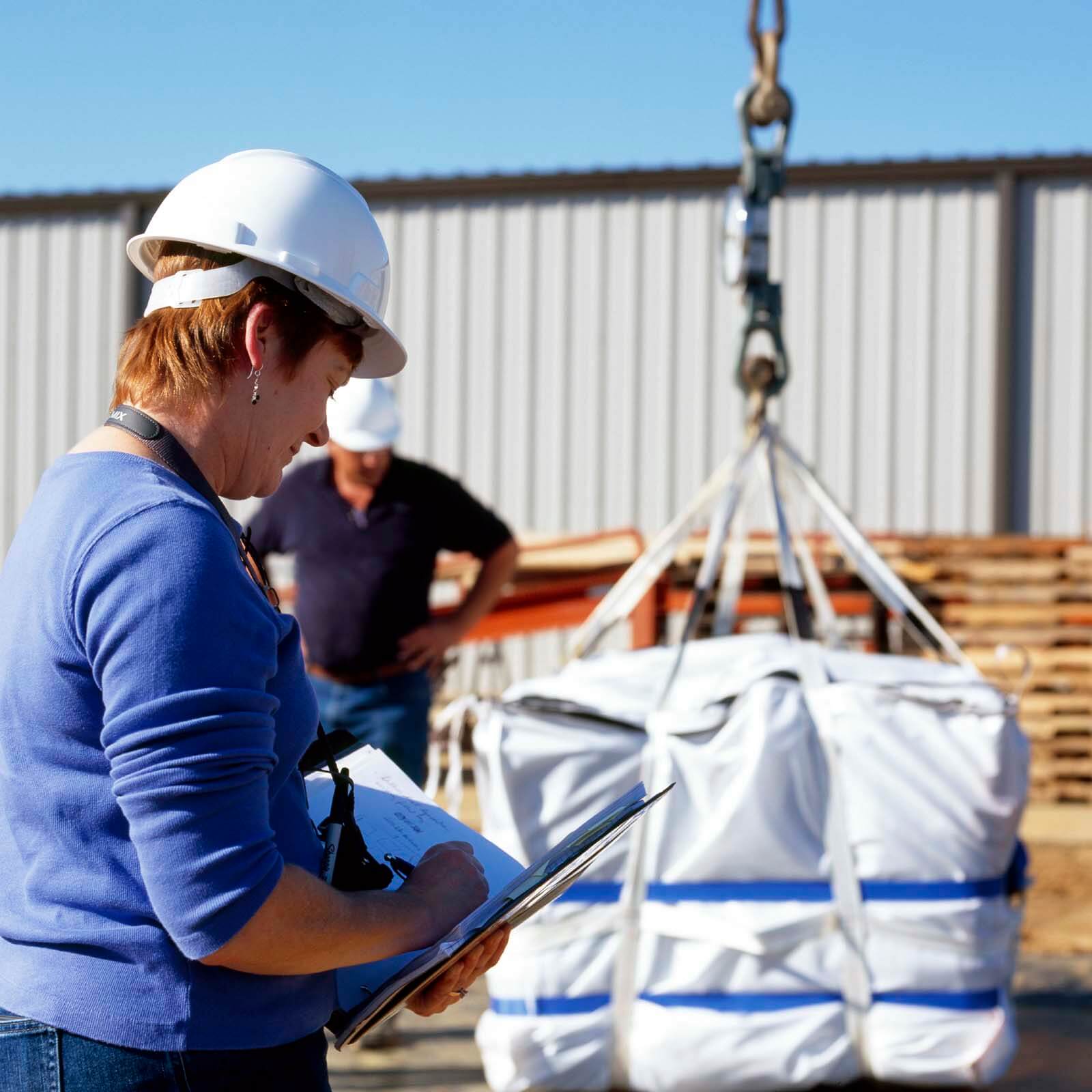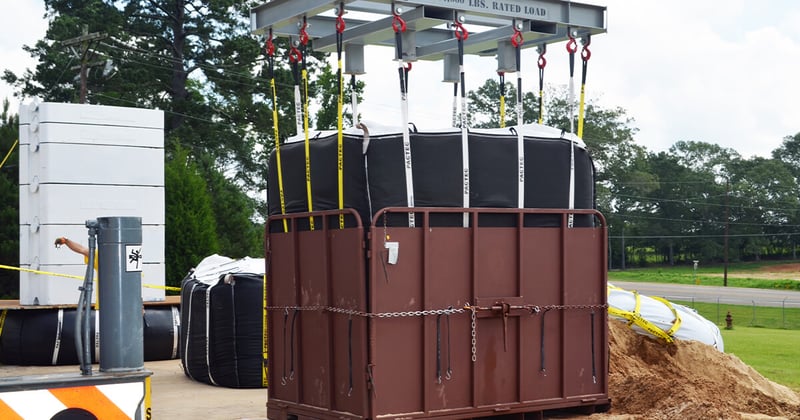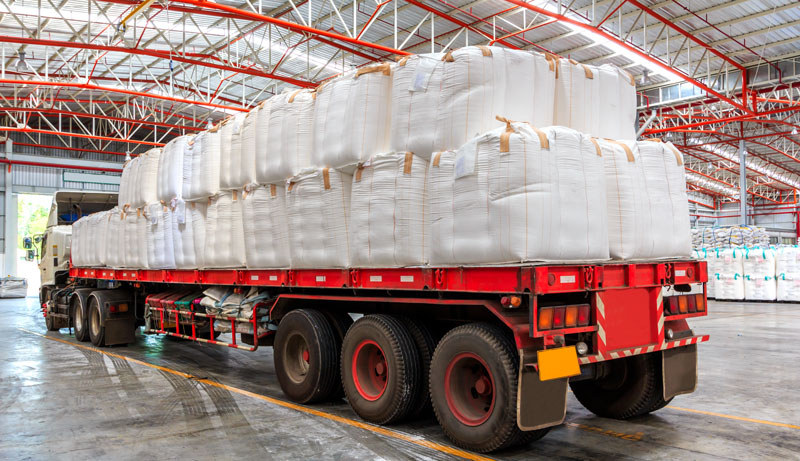The basic FIBC safe handling guidelines apply to any bulk bag. The rules here include selecting the right type of jumbo sack, sticking with the manufacturer's recommendations, and making sure your bag is free of damage. Adhere to these regulations, and you are already halfway there.
Select the Right Bag for Your Product
You might be thinking, "I could just grab any FIBC bulk bag, and it's all good…."
This is hardly the case. Although big bags are generally designed for storing and transporting dry bulk solids, there are different FIBC specifications for different products and environments. For example, some bulk bags are best for transporting farm grains, while others are great for moving hazardous materials.
The first thing you'll want to do is grab the right bag for your product. Look through the ISO international standards and DOT guidelines to know if your materials are compatible with the bulk bag you have in mind.
PacTec also manufactures flexible packaging for Nuclear and Hazardous waste classifications, so if you believe a bulk bag will not meet your transport and disposal specifications, do not fret. PacTec has you covered for all Type IP-1, Type IP-2 and even Type IP-3 needs, plus Macroencapsulation for LLMW. Or contact our experts to discuss your project and packaging needs.
Follow All the Manufacturer's Recommendations
Whether you're a newbie or an experienced FIBC handler, your best bet is to follow the distributor's recommendations whenever you want to choose the right bag. Take some time and go through this free FIBCA guide. Here, you'll see a lot of information on how to select the exact fit for your product.
Before Usage, Check Your FIBC or Bulk Bag for Any Damage
After purchasing your bulk bag, examine it and make sure there are no damages. You would want to look out for tears, loose ends, or areas where the material has thinned or worn off. If you find any damages, report to the right authority, and they'll let you know the steps to take.
Consult With the Manufacturer Should You Have Any Questions or Concerns
If you are unclear how to handle your FIBC, contact your supplier. They are professionals and understand how FIBCs work. Always ask for first-hand information from the manufacturer.
3 Critical Points to Be Aware of When Handling Your Bulk Bag
1. When Lifting Use Every Loop and Never Gather Them Together
As a rule of thumb, always grab and lift your bulk bags by their loops. Loop lifting creates the right balance, which prevents tears, uneven loads and dislodgements.
If you lift your FIBC by a single loop, you'd put too much weight on one of the bag's ends and distort its balance. The loop can cut because of the overbearing weight and drop the bag from its height. This will cause an accident or other far-reaching losses in your facility.
Another thing to note as you lift the bag is that you should avoid placing all the lifting loops on a single hook, unless this is part of your manufacturer's instruction. It is best to speak with your supplier to know how the lift loops on your bag work.
2. Always Keep Your Loops Vertical and Keep the Bag Stable
It’s best if you lift the loops vertically and not horizontally or side-by-side. Raising a big bag in a vertical or sideways position makes it unstable, and poses a great safety risk.
PacTec offers loading and lifting frames that easily hold bags upright in the optimal position for filling and moving. They also reduce the need for additional labor and remove potential loading hazards. The frames fit standard bag sizes and are available to rent or purchase.
3. Never Overload Your Bag, and Always Close It As Instructed
This is one of the most important instructions you should remember. Every FIBC has a maximum load capacity, and if you exceed it, there are enormous safety consequences. For example, the bag's content might spill as you fill, discharge, or transport your items.
Safety Guidelines for Filling or Emptying Your Bulk Bag

Ensure all handling devices are free of sharp edges
Before attaching your bulk bag to crane hooks, forklifts, or other handling devices, check the device for sharp edges or protrusions. The edges of your handling devices should be well-rounded with a 5mm radius.
Never Stand or Place Items Under a Suspended Bulk Bag
No matter what happens, never stand or place items under a suspended bulk bag. If the bag loses its balance at any point, it can tilt and empty its content on you. The bag can suddenly detach from its handling device and drop on anybody who is beneath it.
You already know that FIBC bags hold heavy items, and if any of those materials fall on an individual, they may sustain serious injuries.
Never Go Over the Max Load Capacity
Overfull bulk bags are some of the major causes of industrial accidents. To avoid this, make sure you do not exceed the safe working load capacity when filling your jumbo sack. As a rule of thumb, the ratio of the height of the bag to the width/diameter of the bag should not be more than 2:1.
If you do not know the height-width ratio of your bag, you can use this bulk bag calculator to determine your bulk bag’s capacity.
Make Sure the Bag Bottom Is Always Secured Before Filling
Before filling the bag, check to confirm that the bottom discharge spout is in place. If it isn't, follow the manufacturer's guidelines to secure it properly.
Fill in the Right Environment With the Right Equipment
If you're packing or unpacking flammable material, make sure you do this in a safe environment. Electrostatic energy from flammable material can start a fire and cause severe injury or even death. Again, speak with your manufacturer to confirm that you have the right bag.
How to Safely Store or Transport Your FIBC or Other Bulk Bags
Make Sure All Bags Remain Stable When Stacking
Make sure your filled FIBCs are stable and in the right position when stacking. It would help if you also used the approved pyramid or supported stacking methods to pile up your bags. If you are lifting your bulk bags with a fork lift truck, make sure the fork lift tines are spaced in the right way. Check if all the lifting loops, sleeves, or other lifting devices are vertical, and not twisted.
Don’t Allow a Bag to Overhang On a Pallet
Another thing you should look out for is when your bag overhangs on the side of your handling equipment. Typically, this happens when your pallet is the wrong size. Since there are different specifications for different jumbo sacks, you'd want to speak with your supplier first about this. If the manufacturer approves overhanging for your bag, then there's nothing to worry about.
Properly Secure Your Bulk Bags When Transporting
Do a double-check to confirm that your bags are correctly fixed before transporting them. Poorly secured bags cause several traffic hazards and accidents.
Store Your Bulk Bags Inside, Away From Direct Sunlight
Storing your FIBC outdoors is a safety hazard, as it exposes the bag to damage. Harsh weather, like sunlight and rain can degrade your bulk bags over time. Ultraviolet radiation from the sun weakens FIBCs and accelerates wear and tear. It also drains the strength of your bulk bag.
Keep Them Covered When Stored to Avoid Exposure to Dirt, Dust, or Moisture
In the rare event that dirt or dust interacts with the sack's static electricity, it can cause an explosion. You can protect against this by making sure your bag has an anti-static liner coating for low breakdown voltage.
In Conclusion
Every facility should prioritize the safe handling and use of flexible bulk container bags, especially if you transport dangerous goods. Many times, standard-duty FIBCs are used for storing hazardous materials. One wrong move could mean far-reaching consequences for everyone in the facility, and even innocent passersby.
To keep everyone safe, make sure you adhere to the FIBC industry standards. If you need other professional advice, speak with a PacTec representative – they'll be happy to help.






